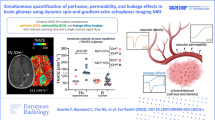Abstract
Accurate MRI characterization of brain lesions is critical for planning therapeutic strategy, assessing prognosis and monitoring response to therapy. Conventional MRI with gadolinium-based contrast agents is useful for the evaluation of brain lesions, but this approach primarily depicts areas of disruption of the blood–brain barrier (BBB) rather than tissue perfusion. Advanced MR imaging techniques such as dynamic contrast agent-enhanced perfusion MRI provide physiological information that complements the anatomic data available from conventional MRI. We evaluated brain perfusion imaging with gadobenate dimeglumine (Gd-BOPTA, MultiHance; Bracco Imaging, Milan, Italy). The contrastenhanced perfusion technique was performed on a Philips Intera 1.5-T MR system. The technique used to obtain perfusion images was dynamic susceptibility contrast-enhanced MRI, which is highly sensitive to T2* changes. Combined with PRESTO perfusion imaging, SENSE is applied to double the temporal resolution, thereby improving the signal intensity curve fit and, accordingly, the accuracy of the derived parametric images. Multi- Hance is the first gadolinium MR contrast agent with significantly higher T1 and T2 relaxivities than conventional MR contrast agents. The higher T1 relaxivity, and therefore better contrast-enhanced T1-weighted imaging, leads to significantly improved detection of BBB breakdown and hence improved brain tumor conspicuity and delineation. The higher T2 relaxivity allows high-quality T2*-weighted perfusion MRI and the derivation of good quality relative cerebral blood volume (rCBV) maps. We determined the value of MultiHance for enhanced T2*-weighted perfusion imaging of histologically proven (by surgery or stereotaxic biopsy) intraaxial brain tumors (n=80), multiple sclerosis lesions (n=10), abscesses (n=4), neurolupus (n=15) and stroke (n=16). All the procedures carried out were safe and no adverse events occurred. The acquired perfusion images were of good quality in all but two patients. Our findings confirm that high relaxivity contrast agents such as MultiHance are ideal for use in perfusion MRI of the central nervous system.
Similar content being viewed by others
Author information
Authors and Affiliations
Corresponding author
Rights and permissions
About this article
Cite this article
Cotton, F., Hermier, M. The advantage of high relaxivity contrast agents in brain perfusion. Eur Radiol Suppl 16 (Suppl 7), M16–M26 (2006). https://doi.org/10.1007/s10406-006-0192-3
Issue Date:
DOI: https://doi.org/10.1007/s10406-006-0192-3




